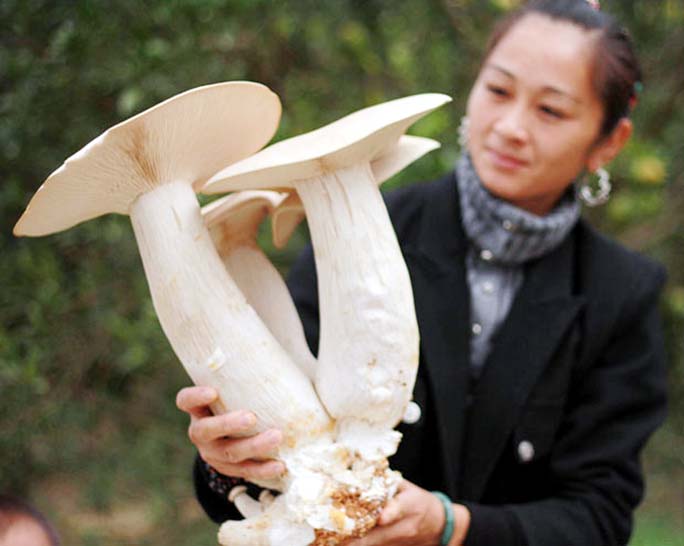
Life Desk :
Once considered exotic, mushrooms – the new superfood – is gaining popularity in the Indian platter, thanks to its versatility. Yes you can bake, toss, stir fry, saute, grill, roast or stuff it, and make your dish go blah to wow in minutes. With the varieties available in market, you now have an inexhaustible list of delicacies to rustle up in your kitchen. Bangalore Times introduces you the various kinds of mushrooms now available in city marts.
Oyster mushrooms: This common edible wild mushroom, now grown commercially across the world, was first cultivated in Germany during World War I as a means of subsistence. It got its name because of its broad fan or oyster shaped cap. It also has a bittersweet aroma, which some believe, has a faint resemblance to the flavour of oysters. The colour of this gilled mushroom varies from white, grey, tan and reddish brown. This variety – known for its tender flesh, velvety texture and mild flavour – is used for salads, soups, sautes, grills and toasts. This mushroom is one of the few known carnivorous mushroom. Yes, it kills and digests parasites to obtain nitrogen! Also, the health benefits are numerous. They are very high in protein, fiber, vitamins B1 and B2, iron and anti-oxidants, and low on fat. They are also known to prevent cancer, high cholesterol and inflammation and high blood pressure. They are also known as tree oyster, straw mushroom, hiratake and tamogitake.
Shiitake mushrooms This edible mushroom is mostly consumed in East Asia, as it grows in warm and moist climate. It is typically cultivated on dead and decaying logs of deciduous trees such as chestnut, oak, maple, beech, ironwood, mulberry and is also known as sawtooth oak mushroom, black forest mushroom, black mushroom, golden oak mushroom and oakwood mushroom. This variety has 10 times the flavour of common white button mushrooms. Known for its pungent, woodsy flavour and meaty texture, shiitake is used in East Asian cuisines. In Japan it is used in soups, steamed and simmered dishes, while in China they are sauteed in vegetarian dishes. In Thailand, they are fried or steamed. In Russia, it is mostly picked. This variety of mushroom is generally dried (to get rid of the umami flavour) and sold as preserved food. Shiitake is high protein, potassium, vitamin B, calcium, magnesium and phosphorus. They also have anti-viral and immunity boosting properties. It is prescribed to fight virus, lower cholesterol and regulate blood pressure.
Shimeji mushrooms: This variety is native to East Asia, but is also found in Northern Europe. They are often called beech mushrooms as they grown on dead beech trees. They have a white base and cracked, speckled brown caps. It has a rich Umami flavour. This variety is always cooked as it is bitter when raw and also lacks the nutritional value that it has when cooked. Once cooked, it has a pleasant, firm, spongy, slightly crunchy and nutty flavour. It is mostly used in stir-fried food and soups, stews and sauces. It can also be sauteed as a whole, including stem and stalk. They are also the perfect accompaniment to noodles. But yes, it is so difficult to grow that its cultivation method has been patented. Because of its petit size and delicate nature, they are harvested in bouquets to protect their vulnerable structure.
Portobello mushrooms: Native to grasslands in Europe and North America, these mushrooms are one of the most widely consumed mushrooms in the world. When immature and white, is known as common mushroom, button mushroom, white mushroom, table mushroom and champignon mushroom. When immature and brown, it is known as Swiss brown mushroom, Roman brown mushroom, Italian mushroom and Cremini mushroom. When fully grown, Portobellos are fairly big in size and have a tender meaty texture and earthy flavour. It has a large, light tan cap. Cooking helps unlock the more subtle flavours of this variety. This variety of mushrooms cooks very quickly in high heat. Hence, it is turned, moved and stirred constantly. Portobellos pair well with most food. Also, these rot quickly when wet. So if you are using water to clean it, cook immediately to minimize wastage. These are an excellent source of copper, phosphorous, vitamin B, potassium, zinc and manganese. Can be refrigerated in paper bag for a week.
Enoki mushrooms: Unlike most mushrooms, Enoki has a mild and delicate – almost fruity flavour – with a slight, crunchy texture. They can be eaten both raw and cooked and are used for salads, soups, sandwiches and pasta sauces. Heat makes them tough, hence, when cooked, they are added at last. They are also known as golden needle or lily mushroom. Enoki mushrooms come in two distinct varieties – wild and cultivated. While the wild variety, grown on mulberry and similar trees, are dark brown in colour and has a shorter and thicker stem, cultivated mushrooms have long, slender white stems with tiny, firm caps. This variety of mushrooms have significant amount of anti-oxidants and protein, apart from vitamin D and B-complex. They can be refrigerated for eight days in a paper bag.
-ToI

